Arrive Delhi.
You will be met on arrival and transferred to your hotel. The representative will also hand over all your documents for travel in India and will also brief you on the tour.
Any Early check-ins can be requested, but cannot be guaranteed.
Stay at The Imperial (heritage room) for 2 nights. An iconic and the most distinguished address situated in the heart of the capital, Hotel Imperial is reminiscent of the halcyon days of the Raj. A luxury hotel, the Imperial Hotel Delhi has an awe-inspiring heritage interwoven in colonial elegance and dwells in its modern delivery of old-style class and magnificence. The royal palms that lead up to the porch are an integral part of and witness to the very creation of Delhi. On arrival, another world opens up filled with Victorian charm and luxury while you revel in the days of the Raj or seek pleasure on your plate at the award-winning restaurants.
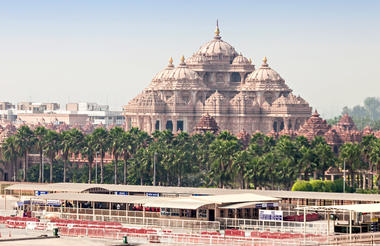

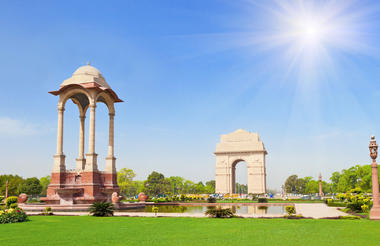
Sightseeing in Delhi
Enjoy a sightseeing and orientation tour of New Delhi. This will include a visit Humayun’s Tomb and Qutab Minar. Drive past India Gate, Rastrapati Bhawan, Parliament house and Connaught place.
The tour of Imperial Delhi will start by visit to the Qutab Minar, the tallest stone tower in India. The Qutab Minar was started in 1199 AD by Qutab-ud-Din Aibak and completed by the sultan's successor and son-in-law, Iltutmish. The building is 72.5 m high and has 379 steps from the bottom to the top. The Minar is tapering with the diameter of the base is 14.3 m while at the top floor it is 2.7 m. The Qutab Minar is still the highest stone tower as well as one of the finest Islamic structures ever raised in India. Then, visit Humayun’s Tomb; built by the widow of the second Mughal Emperor, Humayun, it is an outstanding monument in the Indo-Persian style, a precursor of the Taj Mahal.
The tour also includes a drive past the imposing India Gate, the Parliament building and the RashtrapatiBhawan, the President’s residence. You will also have time to explore the markets in Connaught Place if interested.
Afternoon enjoy a guide tour of Old Delhi which will cover the Juma Masjid, Raj Ghat and a rickshaw ride through the narrow bazars of Chandini Chowk.
Sample some of the famous traditional Savouries while you venture through the Gullies/alleys
Begin with Old Delhi, the Mughal Capital of Shahjahanabad. Visit the Jama Masjid – is the principal mosque of Old Delhi and an important one in India. Commissioned by the Mughal Emperor Shah Jahan, builder of the Taj Mahal, and completed in the year 1656 AD, it is the largest and best-known mosque in India. It lies at the origin of a very busy central street of Old Delhi, the Chawri Bazar Road. The mosque of Friday was built from 1644 to 1658 during the reign of Shahjahan. Later proceed to visit Raj Ghat where Mahatma Gandhi – The Father of the Nation, was cremated and drive pass to visit the Red Fort - the palace for Shahjahan new capital, Shahjahanabad, the seventh Muslim city in the Delhi site. Finally enjoy rickshaw ride in the busy streets of the mile long Chandni Chowk, popularly called “The Silver Street”.



Morning
Morning a short transfer to the Railway Station, board a Superfast train;0810-0950 to Agra (air-conditioned Chair-car carriage)
Stay at The Grand Imperial (Deluxe room) for the night
The Grand Imperial Hotel is a 105 year old Colonial Boutique property, this is centrally located and offers comfortable Accommodation and facilities. Having hosted the Likes of The Crown Prince of England to Lady Mountbatten, now the rooms have a mix of vintage and modern look.
OR at The Oberoi Amarvilas(premier room) for a supplement.
Inspired by Mughal palace designs; with fountains, terraced lawns, reflection pools and pavilions, The Oberoi Amarvilas offers unrestricted views of Taj Mahal from all rooms and suites, complemented by our warm, personalised hospitality.Tastefully appointed accommodation, exquisite restaurants serving authentic Mughal and international cuisines, private dining beside the silhouette of the Taj Mahal and couples spa treatments with Taj Mahal views.
Late afternoon visit the Agra Fort and Taj Mahal
Agra Fort is an outstanding example of Mughal architecture. Agra Fort was the seat and the stronghold of the Mughal Empire under successive generations and the present structure owes its origins to Akbar who erected the walls and gates and the first buildings on the eastern banks of Yamuna River. Shah Jahan added the impressive quarters and the mosque, while Aurangzeb added the outer ramparts. You will visit its Hall of Public Audience and its Royal Pavilions.
Visit The Taj at sunset. Having taken 22 years and 20,000 men to build, the white marble was quarried 200 miles away and was transported to the site by a fleet of 1000 elephants. Built by the Mughal Emperor Shah Jahan as an expression of his love for his wife Mumtaz Mahal, in mid-17th century, it is truly one of the wonders.



Afternoon
Drive to Jaipur (4 hours) visiting Fatehpur Sikri and Abhaneri enroute
FatehpurSikri :Built during the second half of the 16th century by the Emperor Akbar, FatehpurSikri (the City of Victory) was the capital of the Mughal Empire for only some 10 years. The complex of monuments and temples, all in a uniform architectural style, includes one of the largest mosques in India, the Jama Masjid. It offers a unique example of architectural ensembles of very high quality constructed between 1571 and 1585. Its form and layout strongly influenced the evolution of Indian town planning, notably at Shahjahanabad (Old Delhi). The Emperor Akbar (1556-1605) decided to construct it in 1571,on the same site where the birth of his son, the future Jahangir, was predicted by the wise Shaikh Salim Chisti (1480-1572). In1619, Jahangir sought refuge there from the plague that devastated Agra. The site was then finally abandoned, until its archaeological exploration in 1892.This capital without a future, some 40 km from Agra was, however, considerably more than the fancy of a sovereign during the 14 years of its existence.
Chandbaori Stepwell at Abhaneri
Built in 08th-09th century this Four-sided 100 feet deep well with 3500 steps spread over Thirteen stories is an architectural marvel. A good stop (and photo-op) before entering Jaipur
Stay at The Taj Jai Mahal (luxury room with garden view) for 3 nights.
Built in 1745 The Taj Jai Mahal is a stunning piece of Indo-Saracenic Architecture. The hotel offers luxury accommodation, choice of dining in a relaxing and Royal ambience surrounded by acres of manicured Gardens



Morning
Afternoon
Morning enjoy an excursion to Amber Fort and the sights in the city.
The ascent to the fort will be by elephant or jeep. Due to restrictions imposed, elephant ride cannot be guaranteed and is subject to availability on the day. Your driver guide can help you to make suitable arrangements.
Amber Fort was the ancient citadel of the ruling Kachhawa clan of Amber, before the capital was shifted to present day Jaipur. Amber Fort is known for its unique artistic style, blending both Hindu and Muslim (Mughal) elements, and its ornate and breathtaking artistic mastery. Amber Fort is constructed of white and red sandstone. The Fort is unique in that its outside, an imposing and rugged defensive structure, is markedly different from its inside, an ornate, lavish interior influenced by both Hindu and Muslim (Mughal) styles of ornamentation. The walls of the interior of the fort are covered with murals, frescoes, and paintings depicting various scenes from daily life. Other walls are covered with intricate carvings, mosaic, and minute mirror work.
This will be followed by the Monuments in the city.
City Palace, Jaipur, which includes the Chandra Mahal and Mubarak Mahal palaces and other buildings, is a palace complex in the city. It was the seat of the Maharaja of Jaipur, the head of the Kachwaha Rajput clan. The Chandra Mahal palace now houses a museum but the greatest part of it is still a royal residence. The palace complex, which is located northeast of the centre of the grid patterned Jaipur city, incorporates an impressive and vast array of courtyards, gardens and buildings. The palace was built between 1729 and 1732, initially by Sawai Jai Singh II, the ruler of Amber.
Hawa Mahal or the "Palace of the Winds" was built in 1799 by Maharaja Sawai Pratap Singh, and designed by Lal Chand Usta in the form of the crown of Krishna, the Hindu god. Its unique five-story exterior is also akin to the honeycomb of the beehive with its 953 small windows called jharokhas that are decorated with intricate lattice work. The original intention of the lattice was to allow royal ladies to observe everyday life in the street below without being seen. Built of red and pink sandstone, the palace is situated on the main thoroughfare in the heart of Jaipur’s business centre. It forms part of the City Palace, and extends to the Zenana or women's chambers, the chambers of the harem. It is particularly striking when viewed early in the morning, lit with the golden light of sunrise.
The Jantar Mantar a collection of architectural astronomical instruments, built by Maharaja (Ruler) Jai Singh II at his then new capital of Jaipur between 1727 and 1734. It is modeled after the one that he had built for him at the then Mughal capital of Delhi. He had constructed a total of five such facilities at different locations, including the ones at Delhi and Jaipur. The Jaipur observatory is the largest of these.



At leisure to enjoy the Hotel facilities.
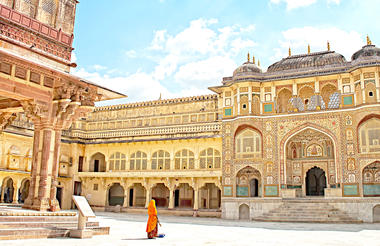


Morning
At Leisure
Transfer to the Airport, to fly to Cochin (via Mumbai)
On arrival you will be met by a hotel Representative and transferred to the hotel
Stay at The Courtyard by Marriott(Deluxe room) for the night



After Breakfast you will be picked up by the Driver and driven to the Backwaters of Kumarakom (2 hours 30 mins)
At midday board a private riceboat (premium 1 bedroom houseboat of Kumarakom Lake Resort) for an over-night cruise on the backwaters.
These boats were traditionally used to transport rice and other produce from the backwaters to markets. These have now been converted to boats for tourists and have modern en-suite facilities. Your luggage travels with you onboard. This cruise on the Backwaters of the Vembanad Lake lets you have a look at the vast expanse of waterways and the village life. Lunch, snacks and dinner will be served onboard. You board the boat at midday, cruise for the afternoon and then anchor for the night at around 5.0pm. Theboat would then be stationary for the night. Please note the Boats are not license to stock Alcoholic beverages (if you are keen on having any please carry your own Drink,Mixers,Tonic water etc and the crew will be happy to serve on-board.)
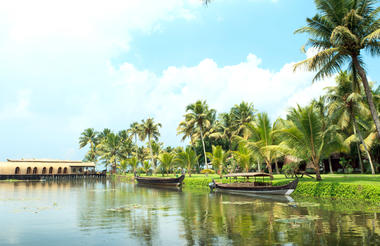
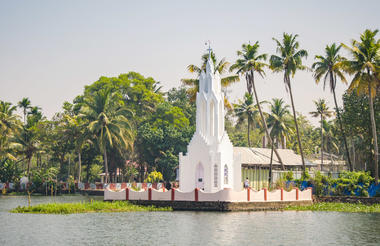

Morning
Disembark after Breakfast and transfer to Cochin (2 hours)
Stay at the Old Harbour (superior room) for 2 nights.
Old Harbour Hotel is a charming Boutique property located in the old quarters of Fort Cochin and just a stone’s throw from the seaside and the Chinese fishing nets, the Old Harbour is a heritage property that was renovated to its original glory. This 300 year old building used to be a residential home to employees of English tea broking firms.



Morning enjoy a tuk-tuk(auto-rickshaw) tour with guide.
Fort Cochi
As you drive through the streets of Fort Cochin the guide will narrate the interesting stories associated with each historic building or mansion which were once either Portuguese homes, Dutch Bastions or British Tea Broking offices. You drive past the Dutch Cemetery by the Beach, Maritime Museum and the Indo-Portuguese Museum. You would visit the Dhobi Ghat, an open-air manual launderette, where the washers do the laundry for homes, hotels and hospitals. You drive into Mattancherry near Jew town, where you would see 13 different communities from India living together in harmony but with very distinct architecture depicted in their houses and temples.
Cochin information
In 1102 CE, Kochi became the seat of the Kingdom of Cochin and has been in prominence since then. With the advent of the Portuguese in 1503, it became the first European Colonial settlement in India and remained the capital of the Portuguese till 1530. It was then invaded by the Dutch and the British and became the first Princely state to join the Indian union post Independence in 1947. The Jews (700 BC onwards), Portuguese (1503-1660), The Dutch (1660-1814) and The British (1814-1947) have left behind their beautiful mark on this characteristic port-city. In 1920 Robert Bristow the harbor Engineer under the direction of Lord Willington spent a good 21 years and transformed this Historic Spice Port into the safest harbor in the Peninsula.
The mains sights include ...
Chinese Fishing Nets
These nets believed to be introduced by the traders from the Courts of the Chinese ruler, Kublai Khan are unique to Cochin. The numerous nets that dot Fort Kochi and Vypeen Island can be seen only in Cochin outside China.Each structure is at least 10 m high and comprises a cantilever with an outstretched net suspended over the sea and large stones suspended from ropes as counterweights at the other end. Each installation is operated by a team of up to six fishermen.
St. Francis Church: Started in 1503 and completed in 1516 by the Portuguese this is the oldest European church in India. It gained prominence as it housed the remains of Vasco Da Gama the Great Portuguese Explorer who first came to Calicut, Kerala in 1498 and died during his third visit in 1524 in Cochin. His remains were exhumed and taken to Lisbon in 1539. The present structure of European architecture is a Protected Monument under the Archaeological survey of India but owned by the North Kerala Diocese of Church of South India.
Dutch Palace: Built in 1557, the Mattancherry Palace was a gift from the Portuguese to Raja Veera Kerala Varma. After its renovation by the Dutch in 1663, it became popular as the Dutch Palace. The palace has medieval charm and comprises a quadrangular structure built in Nalukettu style, the traditional Kerala style of Architecture with a courtyard in the middle. It has three temples that blend beautifully with the European arches. It houses rich murals based on the Indian epics of Ramayana and Mahabharata. The ornate wooden ceiling and the Kerala flooring, which looks like polished black marble but is actually a mixture of burned coconut shells, charcoal, lime, plant juices and egg whites leaves all the visitors intrigued.
Closed on Fridays. Timing: 1000 Hrs- 1700 Hrs
Paradesi Synagogue: One of the oldest and very few functional synagogues, this was built by the European and Middle Eastern Jews in 1568. It is located in Jew Town, adjacent to the Mattancherry Palace temple. Unlike normal Synagogue practice this does not have a Rabbi and is lead by the elders of the community. The main highlights of this place are the Scrolls of the Law, several Gold Crowns, Belgian Glass Chandeliers and a brass-railed pulpit and the floor that has hundreds of 18th century Chinese hand-painted porcelain tiles. The Clock- tower stands top above all.
Timing: 1000 Hrs- 1200 Hrs and 1500 Hrs- 1700 Hrs; Closed on Fridays afternoon & Saturdays.
The Spice Market and Jew Town: The area in between the Synagogue and the Dutch Palace used to the place where most of the spices were traded. Until recent times they even had an old fashioned Pepper Exchange where it was traded. The old spice shops are sadly all but gone but it is still interesting to browse around these narrow lanes. It is dotted with ‘antique’ shops.
Board the local ferry for Ernakulam; the main town where the majority of the population live and work.
Enjoy lunch at one of the local restaurants that do Kerala meals followed by guided tour of the market.
Broadway; Kochi’s oldest shopping corner still bustles with life. Once being the broadest road (that’s how it got its name) it is now sandwiched between MG Road and Marine Drive. This is the most celebrated and happening market with lanes and by-lanes stacked with retail and wholesale shops that sell anything and everything under the sun.
Drive back to your hotel through M.G Road dotted with Textile and Jewelry shops, the driver will be happy to show you around and you can stop at any of the shops.



Morning
Morning
Afternoon
Afternoon
Afternoon
Afternoon
Afternoon
Broadway
Departure to Maldives
Early morning transfer to the Airport (45 mins-1 hour) to board your Flight for Male
Arrival in Maldives
On arrival to the Maldives, you will be transferred by a seaplane to your resort.



Days at leisure



At Leisure
Returning to the UK from the Maldives
The all inclusive package will end after breakfast and you may be required to vacate your room. You will be transferred by seaplane to the Male Airport in time for your departure flight to Heathrow.




